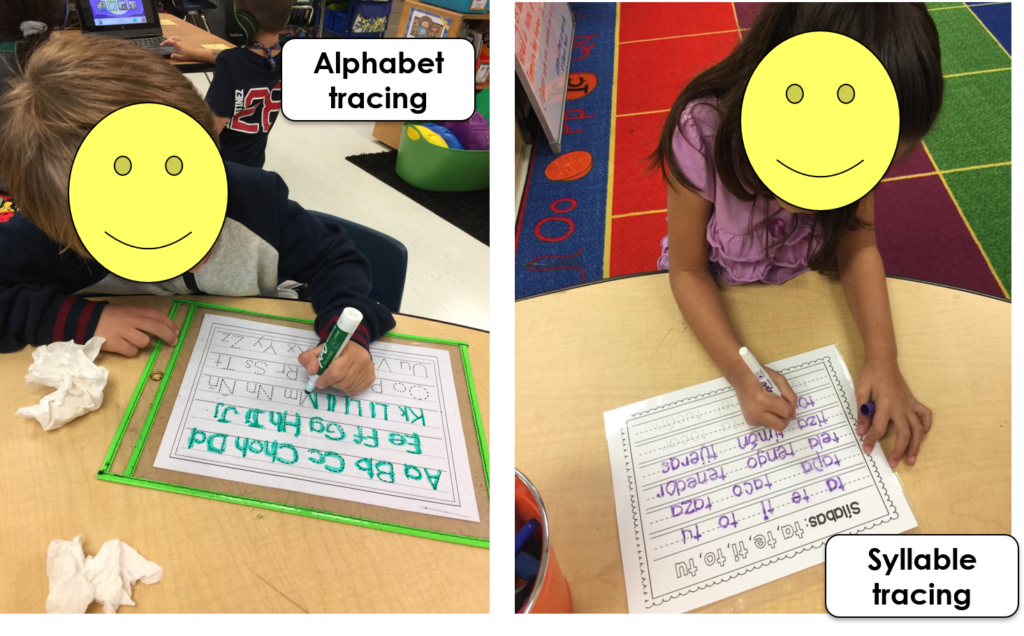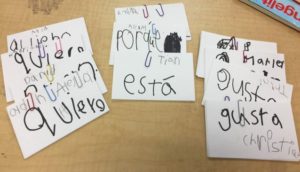
Guided reading is one of the most important parts of any elementary school classroom. In dual language classrooms that should be no different! As Dr. Jose Medina (2017) states, “Guided reading, at its core, is a targeted, specific, and planned instructional activity that helps students improve reading fluency, gain greater comprehension, practice literacy reading strategies, and become strong independent readers…there has to be a specific teaching point….In dual language classrooms, guided reading must include work on metalinguistic and cross-linguistic connections; it is about biliteracy instruction and not English literacy instruction”. Therefore, guided reading time should ultimately include the four literacy skills – speaking/hablando, writing/escribiendo, reading/leyendo and listening/escuchando.
This is how I set-up my center rotations and the “Maestra” rotation is the guided reading time:
My guided reading set-up looks like this:
There are four bins to represent my four different groups. Each bin contains differentiated materials and activities for the week for each group.
My guided reading layout looks like this (and takes about 20 minutes):
1.Independent leveled work
2.Sight Words/Vocabulary/Words-of-the-Week activity
3.Reading/Reading comprehension
4.Reading fluency/Oral Language
5.Writing (lecto-escritura)
I will go into what I do in each part of the guided reading layout and examples of activities for each:
1. Independent Leveled Work (trabajo independiente):
- Tracing (alfabeto, vocales, sílabas abiertas, sílabas trabadas, frases, palabras importantes, oraciones
- Reading independent books (books you’ve read together before or are appropriate for their level)
- Sight Words/Vocabulary/Words-of-the-Week activity
2. Sight Words/Vocabulary/Words-of-the-Week activity (Palabras de alta frecuencia/Vocabulario/Actividades con las palabras de la semana)
- Introduce vocabulary using TPR—Total Physical Response (aplausos, movimiento físico (de los brazos, las manos) – don’t be afraid to get your students active during guided reading!
- Work with the words you have been teaching (trabajar con las palabras que has enseñado durante la semana/las semanas anteriores usando juegos y actividades interactivas)
3. Reading/Reading comprehension (lectura/comprensión lectora)
- Antes de leer un libro:
- Paseo por el libro–mira las ilustraciones
- Mirar la estructura del texto
- ¿De qué crees que se tratará el libro? ¿Por qué?
- Leer el libro
- Cuando el estudiante se detenga en una palabra o diga la palabra en ingles o una palabra incorrecta, ¿qué estrategia podrías utilizar en ese momento para ayudar al estudiante?
- Después de la lectura
- Preguntas: (1) Sobre el texto y (2) Mas allá del texto
- Hablen sobre el cuento (Taxonomía de Bloom)
4. Reading fluency/Oral Language (Fluidez de lectura / lenguaje oral)
La fluidez de lectura es la capacidad de leer con precisión, sin problemas y con expresión. Los lectores con fluidez reconocen las palabras automáticamente, sin tener problemas con los problemas de decodificación. Suenan naturales, como si estuvieran hablando. La fluidez es importante porque une el reconocimiento de palabras y la comprensión.
5. Writing (lecto-escritura)
La lecto-escritura implica un proceso en el cual están involucradas diferentes etapas en las que se producen adquisiciones que tienen que ver con el descifrado, la comprensión, interpretación, composición y redacción. This includes: deciphering, understanding, interpretation, composition and writing.

























